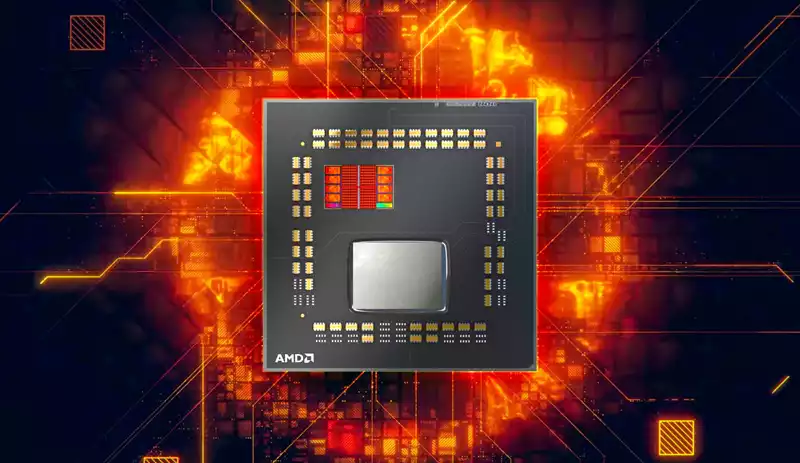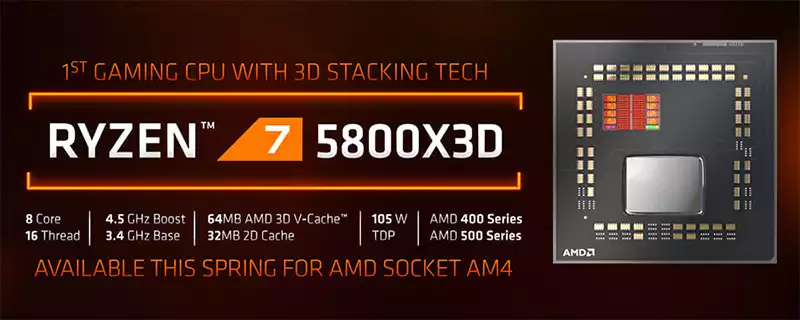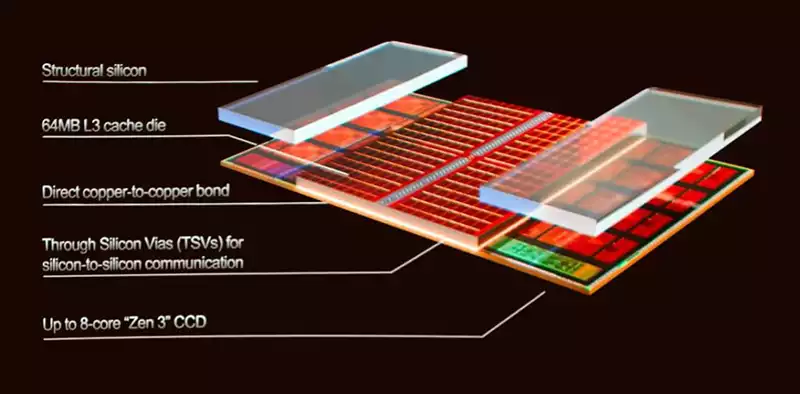You can also be interested in these:
- AMD Ryzen 7000X3D: What to expect from these new CPUs?
- AMD Zen 3 vs Zen 4: The evolution and revolution
- Who leads the battle of the CPUs in 2023?
- AMD Ryzen 9 7950X3D CPU full review
AMD is about to launch a new desktop chip, the AMD Ryzen 7 5800X3D, which should be available to consumers in spring 2022. It’s the first Ryzen chip that uses 3D V-Cache technology, and it’s AMD’s answer to the Core i9-12900K codename Alder Lake, released in 2021.

This is not a brand-new chip but is a retrofit of the AMD Ryzen 7 5800 with the added 3D cache, so it can easily slot into any existing works with full backward compatibility. Follow along as we go through the new chip, and you can see if you would consider this CPU for an upgrade or not before you make your next purchase.
What Is 3D V-Cache Technology?
Processors or chips use cache to store and access information faster than going out to the main memory. You have differing levels of cache that offer different sizes and access speeds, L1 cache is the smallest and fastest, with the L3 cache being the largest but slowest, and L2 is just in the middle. Each cache will feed into the next level until it reaches the processor, so L3 > L2 > L1 > Processor.
L2 and L3 cache act as a backup for the L1 cache, and while they’re slower, they can still boost the system’s performance by offering additional cache when the L1 cache becomes full or overused.

3D printing technology now allows more complex cache to be built and stacked on top of each other, which increases the space available to all levels of cache. So with a 2D cache, you were limited to 64MB of L3 or potentially less, but with a 3D cache, you can now stack it to provide a maximum of 192MB of total L3 cache at a much faster speed.
What’s interesting is that this is just the first step, with Taiwan Semiconductor Manufacturing Company (TSMC) showing that they can stack up to 12 layers of cache, which would skyrocket the amount of available memory.
What’s the benefit of 3D V-Cache to gamers?
Gamers will see increased performance on lower-spec chips, with AMD showing performance metrics of 15% improvement from the AMD Ryzen 7 5800X3D over the AMD Ryzen 9 5900, which has more threads and cores available to it.
The potential is enormous, considering this is the first option available with stacking of the cache potentially going higher as AMD releases newer chips in the future.
AMD has already said they will be introducing 3D V-Cache to their higher-end chips, which would mean even greater performance benefits if you’re willing to pay the price.
AMD Ryzen 7 5800X3D specs
With the AMD Ryzen 7 5800X3D just being a retrofit of the AMD Ryzen 7 5800, you would expect everything else to be exactly the same. However, it’s clocking in slightly lower, with a base clock of 3.4Ghz and a boost clock to 4.5Ghz, whereas the AMD Ryzen 7 5800 has a base of 3.8Ghz with a boost clock to 4.7Ghz. This may be due to the extra wattage required by the additional 3D cache.
It has the same 8 cores with 16 threads, and those cores are all Zen3 based, and it has the same 105W TDP.

The standard model without 3D cache comes with 32MB cache, but with 3D V-Cache tech, it’s got 96MB available for use, which is 12MB per core. This is more cache than is available on the higher-end models like the Ryzen 9 5950X.
It’s backward compatible with most AM4 sockets, and there shouldn’t be any problems in overclocking it as with the original model.
What’s disappointing is that with newer AMD releases coming, such as AM5 and Zen4, this will be the last chip on the AM4 socket, so if you buy it, you’ll need to be performing extra upgrades later when you want to upgrade the chip further.
AMD Ryzen 7 5800X3D performance
The AMD Ryzen 7 5800X3D is around 15% faster than the Ryzen 9 5950X on 1080p though the performance benefits get lower as the resolution increases. It has slight performance benefits over the Intel Alder Lake Core i9-12900K, and in some cases, they’re just neck and neck in performance.
However, when you consider the AMD Ryzen 7 5800 gets nowhere near these models, it’s easy to see that the 3D V-Cache technology is adding huge performance gains to the chip, which will be exciting as the technology is moved into the higher-end chips that AMD will be releasing in the future.
AMD isn’t giving full performance stats at the moment and simply saying it’s the “Fastest Gaming Processor” which indicates the stats may not be hugely impressive. However, when compared to the cost, it’s beating the Core i9, which is significant.

The other interesting thing is that the available performance stats show that the AMD Ryzen 7 5800X3D outperforms other chips in newer games and only matches other chips in older games, so that’s a good trend and something to do note depending on what games you’re playing.
The AMD Ryzen 7 5800X3D seems to be specifically geared towards gamers rather than general users, so the 3D V-Cache technology may not provide any real benefits to standard power users that aren’t gaming.
How much will the AMD Ryzen 7 5800X3D cost?
There haven’t been any prices released as yet; however, it would be expected that the AMD Ryzen 7 5800X3D has a higher price than the standard AMD Ryzen 7 5800 and may sit around the cost of a Ryzen 9 5900X.
We can only speculate and wait for the chip to be released on the market to see what AMD does.
Final thoughts on the AMD Ryzen 7 5800X3D
The AMD Ryzen 7 5800X3D is an exciting chip, but mainly for the use of 3D cache that will have significant benefits to all chips that use it going forward. However, the AMD Ryzen 7 5800X3D itself may not be a good purchase if you’re looking for a long-term chip, as it’s the first and also potentially the last using AM4 sockets, so you may have some bigger upgrades required in the future rather than just a chip upgrade.
More stories like this
- AMD Ryzen 7000X3D: What to expect from these new CPUs?
- AMD Zen 3 vs Zen 4: The evolution and revolution
- Who leads the battle of the CPUs in 2023?
- AMD Ryzen 9 7950X3D CPU full review
- AMD X570 vs X570S: What is the best AMD chipset?
- AMD FidelityFX Super Resolution 2.2 reinventing the game